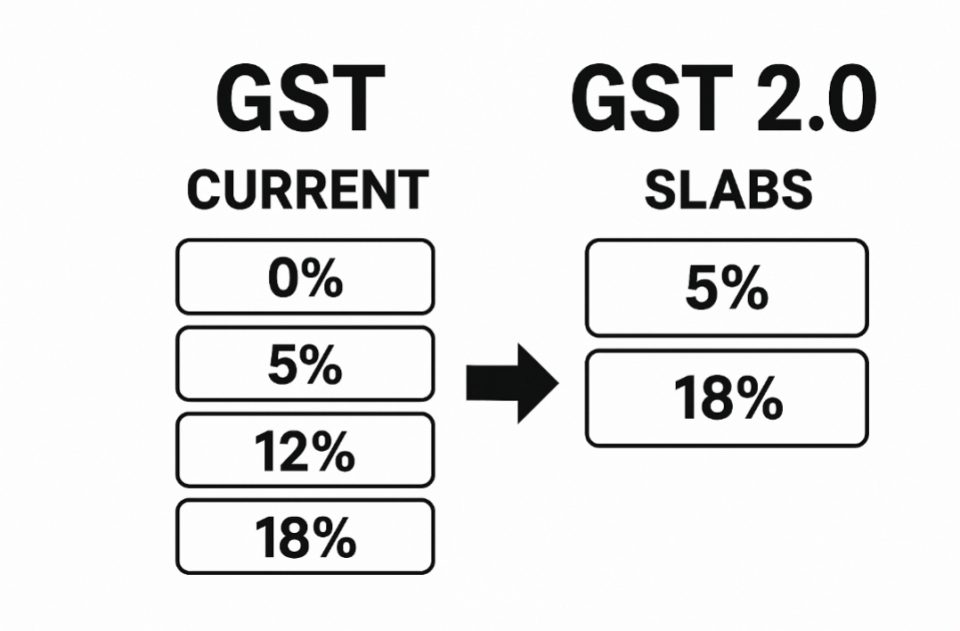GST 2.0: The Game-Changing Announcement
Therefore, India stands on the brink of its most significant tax transformation since GST’s inception in 2017. Furthermore, Prime Minister Modi’s announcement of “GST 2.0” represents more than incremental policy adjustment. Consequently, this radical restructuring promises to reshape how 1.4 billion Indians shop, spend, and save.
Moreover, the timing couldn’t be more strategic. Additionally, with global trade tensions mounting and tariffs threatening exports, India turns inward to unleash its consumption engine. Subsequently, this transformation will create ripple effects across every sector of the economy.
Understanding the Revolutionary Two-Tier Structure
Nevertheless, the current GST system operates like a complex maze with five different rates. Meanwhile, consumers navigate between 0%, 5%, 12%, 18%, and 28% slabs, creating confusion and compliance nightmares. However, the proposed structure dramatically simplifies this landscape.
Specifically, the new framework consolidates everything into primarily two rates: 5% and 18%. Additionally, nearly 99% of items currently taxed at 12% will move to the lower 5% bracket. Similarly, approximately 90% of goods in the 28% category will shift to 18%.
Furthermore, luxury and sin goods will face a new 40% rate, replacing the highest 28% slab. Nevertheless, essential items remain exempt at 0%, ensuring affordability for basic necessities.
The Customer Experience Revolution Begins
Crucially, this reform fundamentally transforms the Indian shopping experience. Initially, consumers faced decision paralysis when comparing products across different tax brackets. Now, however, simplified pricing structures eliminate this complexity.
Moreover, businesses can streamline their operations significantly. Previously, retailers struggled with inventory management across multiple tax categories. Subsequently, the two-tier system reduces compliance costs and administrative burden.
Additionally, digital transformation accelerates as companies implement unified pricing strategies. Consequently, e-commerce platforms can offer more transparent pricing models. Furthermore, quick commerce services benefit from simplified tax calculations.
Economic Impact Analysis: The Numbers Tell the Story
Remarkably, expert projections suggest massive economic benefits from this transformation. Specifically, SBI Research estimates a consumption boost worth ₹1.98 lakh crore directly from GST reforms. Additionally, combined with income tax cuts, total additional consumption could reach ₹5.31 lakh crore.
Therefore, this represents approximately 1.6% of India’s GDP flowing back into the economy. Moreover, analysts project the reforms could reduce inflation by 25-60 basis points. Subsequently, household purchasing power increases substantially.
Furthermore, the automotive sector anticipates significant benefits as cars move from 28% to 18% taxation. Similarly, consumer durables like air conditioners become more affordable for middle-class families.
Consumer Behavior Transformation in the Digital Age
Interestingly, Indian consumers increasingly prioritize value over brand loyalty. Previously, 52% of consumers switched to private labels seeking better pricing. Now, however, GST reductions democratize access to branded products.
Additionally, Gen Z consumers drive experiential consumption patterns. Moreover, their digital-first approach aligns perfectly with simplified tax structures. Subsequently, online shopping becomes more predictable and transparent.
Furthermore, rural consumption patterns evolve rapidly with improved affordability. Meanwhile, urban consumers redirect savings toward discretionary spending categories. Consequently, the entire consumption pyramid benefits from these changes.
Sectoral Winners: Industries Poised for Growth
Particularly, the automotive industry expects substantial demand revival. Currently, cars taxed at 28% will see prices drop by approximately 8-10%. Therefore, middle-class families can finally afford vehicle upgrades.
Similarly, consumer electronics benefit tremendously from reduced taxation. Previously, smartphones, televisions, and appliances carried heavy tax burdens. Now, however, these items become accessible to broader demographics.
Moreover, the textile and apparel sector anticipates increased demand. Additionally, footwear below ₹500 remains at 5%, benefiting mass-market consumers. Furthermore, premium clothing sees reduced taxation, boosting discretionary spending.
Middle-Class Empowerment Through Tax Relief
Crucially, the reforms specifically target India’s expanding middle class. Previously, this demographic felt squeezed between rising prices and stagnant incomes. However, combined tax reliefs provide substantial breathing room.
Specifically, income tax exemptions up to ₹12 lakh annually complement GST reductions. Therefore, a middle-class family saves between ₹30,000-₹1,10,000 annually from income tax cuts alone. Additionally, GST savings add another layer of relief.
Consequently, discretionary spending power increases significantly. Moreover, families can allocate more resources toward education, healthcare, and lifestyle upgrades. Subsequently, service sectors experience increased demand.
Implementation Challenges and Timeline Considerations
Nevertheless, successful implementation requires careful coordination between center and states. Previously, GST Council meetings faced resistance over revenue sharing. However, current proposals address state concerns through compensation mechanisms.
Furthermore, the Diwali timeline creates urgency for rapid execution. Meanwhile, businesses prepare for system upgrades and process changes. Additionally, consumer awareness campaigns become crucial for smooth transition.
Moreover, technology infrastructure must support the simplified structure. Subsequently, billing systems, accounting software, and compliance platforms require updates. Therefore, the government coordinates with industry stakeholders for seamless rollout.
Market Response and Investor Sentiment
Accordingly, equity markets responded positively to reform announcements. Specifically, consumer-facing stocks witnessed immediate gains across sectors. Furthermore, mutual fund managers increase exposure to consumption themes.
Additionally, foreign institutional investors view reforms favorably. Moreover, simplified tax structures attract more international businesses to India. Subsequently, FDI flows into consumption-oriented sectors accelerate.
Therefore, market experts project continued optimism through festive seasons. Meanwhile, consumption stocks could outperform broader indices significantly. Consequently, long-term investment themes shift toward domestic demand stories.
Technology Integration and Digital Experience Enhancement
Importantly, GST 2.0 accelerates India’s digital transformation journey. Previously, complex tax calculations hindered e-commerce growth. However, simplified structures enable better customer experiences across platforms.
Moreover, artificial intelligence systems can optimize pricing strategies more effectively. Additionally, machine learning algorithms predict consumer behavior patterns accurately. Subsequently, personalization improves dramatically across digital touchpoints.
Furthermore, mobile-first commerce benefits tremendously from transparent pricing. Meanwhile, regional language platforms can explain tax implications clearly. Therefore, digital inclusion expands to previously underserved demographics.

Regional and Rural Market Implications
Specifically, tier-2 and tier-3 cities emerge as major beneficiaries. Previously, complex tax structures deterred organized retail expansion. Now, however, simplified GST enables broader geographical reach.
Additionally, rural consumers gain access to branded products at competitive prices. Moreover, agricultural input costs decrease through favorable tax treatment. Subsequently, farmer purchasing power increases substantially.
Furthermore, regional manufacturers compete more effectively with national brands. Meanwhile, local entrepreneurs benefit from reduced compliance burdens. Therefore, the entire MSME sector receives a significant boost.
Long-term Vision: Building a $10 Trillion Economy
Ultimately, GST 2.0 serves Modi’s ambitious $10 trillion economy vision. Previously, consumption contributed approximately 60% to India’s GDP. However, enhanced affordability drives this contribution higher.
Moreover, formalization accelerates as businesses find compliance easier. Additionally, tax base expansion generates higher revenues despite reduced rates. Subsequently, the government achieves sustainable fiscal health.
Furthermore, manufacturing competitiveness improves through reduced input costs. Meanwhile, services sectors benefit from increased domestic demand. Therefore, all growth engines fire simultaneously.
Preparing for the Transformation
Consequently, businesses must prepare comprehensively for this transition. Initially, pricing strategies require complete overhaul across product portfolios. Meanwhile, supply chain costs need recalculation with new tax structures.
Additionally, customer communication becomes crucial during transition periods. Moreover, sales teams require training on new pricing models. Subsequently, marketing campaigns must highlight affordability improvements.
Furthermore, technology systems need urgent upgrades before implementation. Meanwhile, accounting processes require standardization across the simplified structure. Therefore, change management becomes critical for success.
The Diwali Promise: A Festival of Economic Growth
Finally, Modi’s promise to deliver GST 2.0 by Diwali carries symbolic significance. Traditionally, this festival marks new beginnings and prosperity. Similarly, tax reforms herald a new chapter in India’s economic journey.
Moreover, festive season timing maximizes consumption impact immediately. Additionally, holiday shopping benefits from reduced prices across categories. Subsequently, the economy receives a powerful stimulus precisely when needed.
Therefore, GST 2.0 represents more than tax policy reform. Instead, it embodies India’s commitment to inclusive growth and consumer empowerment. Consequently, the transformation promises to reshape how Indians experience commerce, consumption, and economic participation in the digital age.

